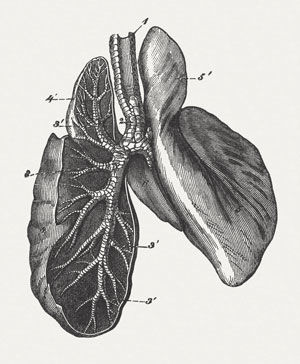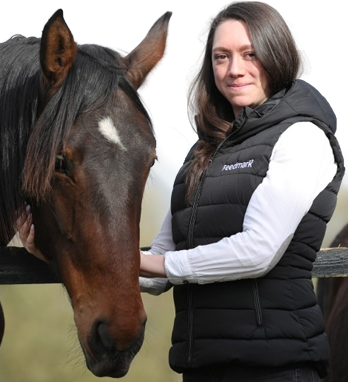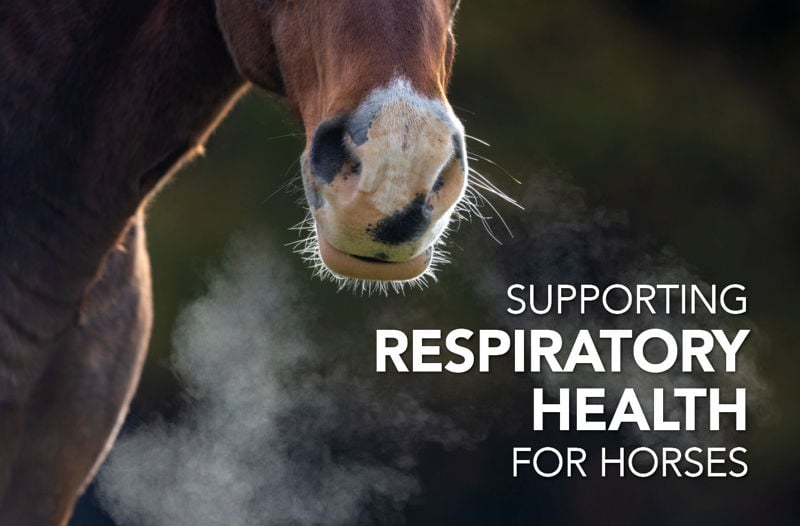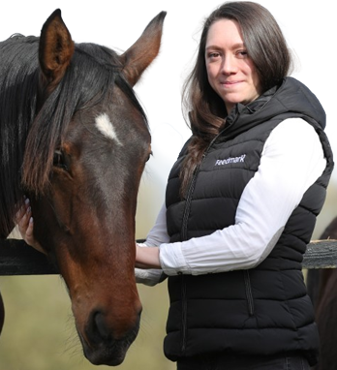Being the third largest organ in the horse’s body, the horse’s lungs are uniquely designed to maximise airflow and oxygen uptake. Maintaining respiratory health for horses is crucial as even minor respiratory issues can impact performance.

Image: Structure of the horse’s respiratory tract
Horses are unable to breathe through their mouths, so the respiratory tract begins with the nostrils. Air travels down the trachea to the bronchi, then into smaller structures called bronchioles within the lungs1. At the end of the bronchioles are small sacks called alveoli where oxygen and carbon dioxide are exchanged between the lungs and the circulating blood. Oxygen is taken around to body to where it is required, and carbon dioxide (a waste product of cell metabolism) is expelled when the horse breathes out2.
Did you know?
- Horses are obligate nasal breathers.
- At trot the horse breathes in 5 litres of air with each breath.
- At gallop the horse takes 140 breaths per minute – the equivalent of 6 bathtubs of air.
- Horses hold their breath when they jump.
- The horses diaphragm controls breathing during canter and gallop.
- Total lung capacity of the horse is around 60 litres.
The horse’s lungs are highly specialised, and because of this, respiratory health is of particular importance.
Respiratory diseases in horses
Respiratory issues in horses can be triggered by infectious and non-infectious causes. Infectious causes include influenza and strangles, and non-infectious causes are allergens such as dust and pollen which can cause equine asthma and chronic obstructive pulmonary disorder (COPD).
Performance limiting respiratory disorders include upper respiratory tract dysfunction (roaring), inflammatory airway disease and exercise induced pulmonary haemorrhage (EIPH).
Signs that may indicate problems with equine respiratory health include:
- Coughing
- Nasal discharge
- Reluctance to work / decreased performance
- Fever
- Swollen lymph nodes
Importance of Respiratory Heath for Horses
The function of the respiratory system is to provide oxygen to areas of the body that require it and remove carbon dioxide2. During each breath, the horse inhales 4-5 litres of air3 and the oxygen they inhale is essential for energy metabolism4. Exercise increases the energy requirement of the muscles and during exercise, the respiratory rate needs to increase to compensate for the raised oxygen requirement of the muscles5.

Image: Alveolus Gas Exchange
Respiratory health also plays a vital role in the immune function of the horse. The epithelium in the horses’ airways is the first line of defence against pathogens6 and provides a protective barrier to stop entry of pathogens into the alveoli. Entry of pathogens triggers an inflammatory response and can lead to infectious lung diseases. Microscopic airborne particles can get deep into the lungs where they cause irritation and inflammation. These particles come from bedding, forage, feed, and the horse’s environment and can include mould spores and bacteria. Once these particles have been inhaled, an immune response is triggered7 within the lungs which leads to the production of mucus in the bronchi and bronchioles. This mucus is resistant to being expelled and sits within the lower lung structures. If the lining of the bronchioles thickens and causes constriction of the bronchioles, the effort required for breathing greatly increases.
If the horse develops a sensitivity to these particles, horses seem to be continually affected, having repeated reactions which can make management of the horse difficult.
Supporting Respiratory Health for Horses
In addition to a balanced diet, following correct management practices will help to maintain equine respiratory health. Ensuring that your horses stable is dust free, feeding dust free forage such as haylage or dampened, soaked, or steamed hay, feeding forage from the floor, and using dust free bedding will also help to support respiratory health and reduce the risk of respiratory diseases.
Allowing a greater proportion of time outside, and minimising time in the stable will help, however if stabling is necessary, due to poor weather for example, ensure that the stable is well ventilated with good air flow.
For any advice or questions you may have, please don't hestiate to reach out to our expert nutrition team. You can call 0800 585525 Monday-Friday 8:30am-5:00pm. Email [email protected], or send us a DM on social media.
References
1Lekeux, P., Art, T., & Hodgson, D. R. (2014). The respiratory system: Anatomy, physiology, and adaptations to exercise and training. In: Hodsen, D. R. & Rose, R.J. (Eds.) The Athletic Horse: Principles and Practice of Equine Sports Medicine: Second Edition. WB Saunders: Philadelphia, USA.
2Mazan, M. (2022). Equine exercise physiology—challenges to the respiratory system. Animal Frontiers, 12(3): 15-24.
3Robinson, N. E. (2007). Chapter 2 - How horses breathe: The respiratory muscles and the airways. . In: McGorum, B. C., Dixon, P. M., Robinson, E. N., & Schumacher, J. (Eds.) Equine Respiratory Medicine and Surgery. Saunders Elsevier: China.
4Franklin, S. H., van Erck-Westergren, E., & Bayly, W. M. (2012). Respiratory responses to exercise in the horse. Equine Veterinary Journal, 44(6): 726-732.
5Franklin, S. H., van Erck-Westergren, E., & Bayly, W. M. (2012). Respiratory responses to exercise in the horse. Equine Veterinary Journal, 44(6): 726-732.
6Martin, T. R., & Frevert, C. W. (2005). Innate immunity in the lungs. Proceedings of the American Thoracic Society, 2(5): 403-411.
7Gilkerson, J. R., Bailey, K. E., Diaz-Méndez, A., & Hartley, C. A. (2015). Update on viral diseases of the equine respiratory tract. Veterinary Clinics of North America - Equine Practice, 31(1): 91-104.



